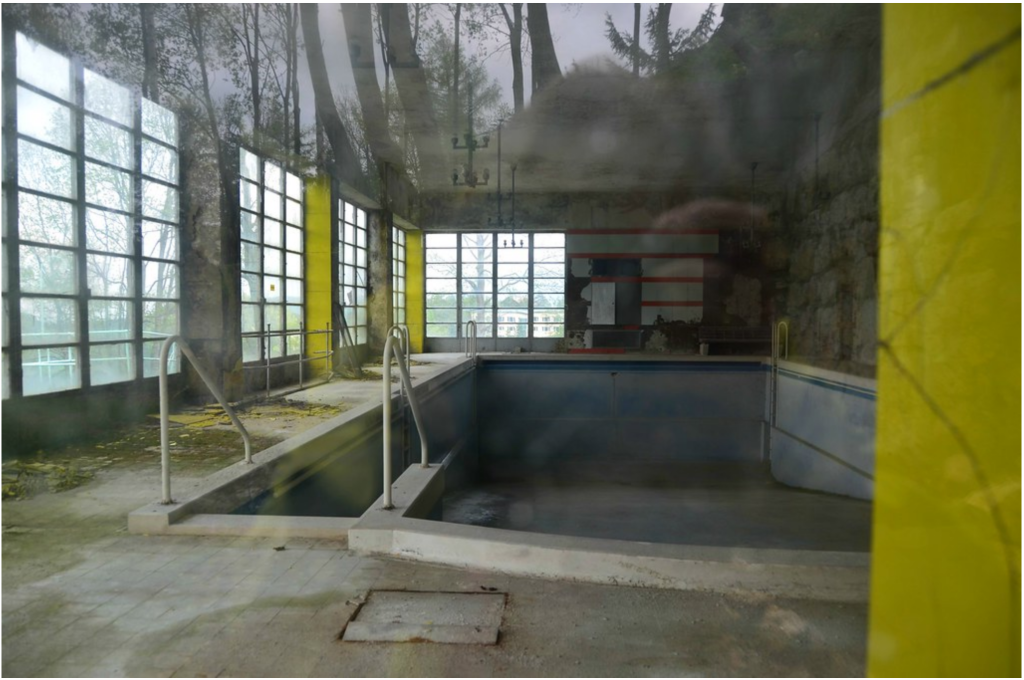Duchamp’s readymades, Tatlin’s counter-reliefs or Hugo Ball’s appearance as the “magic bishop" reciting his Karawane, are all works displayed in different cultural circumstances in the time of the WWI. For us they exist as photographs of the crucial moments of the fully-fledged advent of Avant-Garde art. As radical events in the history of exhibiting (that will be briefly overviewed in the talk), these three works transcend the barrier of the media-based art (of “aesthetic modernism”) and develop a new sense of presentation of works in relation to established exhibition standards, and particularly to the ideological relation of the “work of art” and the “artefact”.
This semester's Art-Based Investigation will be working in close connection with the Integral Design Studio: The Sublime Landscape and its Relation to Labour, based on which students will be developing exhibiting concepts.
This will be part of an exhibition ''Land, Property and Commons'' taking place at the indoor pool of the Südbahnhotel in Semmering.
Contemporary life whittle down dimensions of apartments and shifts our lives outside to the public sphere. We head out to spaces designated for work, producing, learning, entertainment, etc. At a sudden moment, this was all put to a halt. We found ourselves confined within the apartments we had spent very little time in, away from others. All we used to accomplish ‘’outside’’ now had to be done from within our spaces of privacy. Meanwhile, when we head outside, we experience the world alone. Although public spaces are accessible, we go through them on our own, collective experience is, at this moment, impossible. We exist in the world, but to each of us, the world has a post-apocalyptic feeling, and we are, in fact, alone.
In our confinement, we thought about ‘’Exhibiting the Thing.’ ‘’Removed from the Crowd: Unexpected Encounters’’ by Ivana Bago, Antonia Majaca, Vesna Vukovic, Lucian Gommoll, Lissette Olivares, Aleksandra Jach, Miguel A. Lopez, Natasa Petersin-Bachelez, ‘’Unmarked’’ by Peggy Phelan and ‘’Counter Public Sphere’’ by Alexander Kluge were an essential influence to our thought development and work process.
But how do we ‘’Exhibit the Thing,’’ when the artwork also finds itself in confinement? From this question, more complex questions arise. We think about the finished artwork in its confinement, but also about the art which is still being conceived in artists’ minds. Can we say that the art is born before its exposure to the audience? What then is the nature of it, when it cannot reach and influence the other? And what is the relationship that it has with this audience, who know that the art exists, long to encounter it, but have no access to it?
And even if we were able to approach art, this distance that we were obliged to keep in relation to the artwork now applies to the distance we must keep between each other. Can we really experience the art without others? When we cannot approach others, in relation to the artwork, is our experience complete? What happens then when this collective experience is impossible?
We observe a disruption of relations between the artist, artwork, and audience, and realize that while accessibility to the artwork is more restricted, the state in which it exists now brings more freedom when it comes to definitions.. Is now the time to liberate art from the institution, from the rigid pre-defined relationship between the artist, the artwork, and the audience? We observe these relations become blurry in Goran Trbuljak’s work, ‘’Painting on Glass (Sunday Painting)’’, and we encounter these blurred boundaries again while developing and exposing artworks during the lockdown. It is time to revisit exhibiting and curating outside the institutions which define the relations.
Our questions, however, could not have stopped with art, we are confronting ourselves in a way most of us have never done before. Who are we during and after confinement? Do we really exist without the other? As we experience a tangible, abrupt change in our perception of space, time, and the other, we realize that our identities seek to be revisited. Perhaps the idea of identity itself has to be rethought as well. This close look into identity also brings into question terms such as nationality, localism, and nationalism and our own position between these concepts.
Confinement also brings questions about itself, what should remain inaccessible? What should, even in art, remain hidden from others? And what happens when we, in reverse, bring out the most intimate objects to the public space?
The trigger for this exhibition and lots of the subject matter was the current unprecedented situation. The issues of isolation, restriction of free movement either of individuals or products, questioning the politicians and media, our national identity, or exploring the relation to our own intimacy are present and bounding all the works altogether.
Artworks reflect the difficult times in which they originated. They are investigating our relations with the public sphere by confronting it with imminent personal intimacy.
How do you exhibit the artwork when all the venues are closed? Is it even pertinent in such times? And who can decide it? Galleries tend to attract certain groups of people, but how to engage with the broad public and escape this vicious circle of tendentious institutions and elitist audience?
Budour Khalil & Eva Truncova
